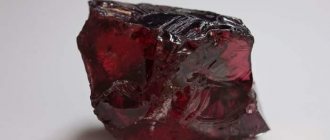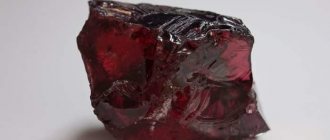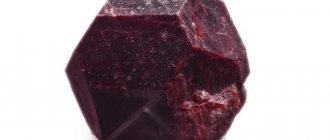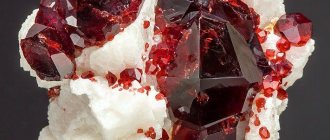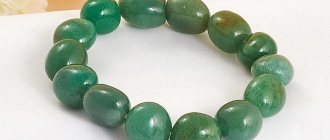The gem is mentioned in many legends and traditions, where the most incredible properties are attributed to it. However, most of them are just fiction. The real properties of pomegranate are less fantastic, but still useful. We will help you separate truth from fairy tales and share information about who this stone will suit according to your horoscope.
Physical and chemical properties
All varieties of garnet are silicates, in which the content of certain elements (magnesium, manganese, iron, aluminum, chromium and calcium) determines the appearance, properties and color. Physically, garnet is a hard mineral, but it is also quite brittle. Its remaining properties are listed in the following table.
| Formula | R2+3 R3+2 [SiO4]3 – general formula, where R2+ is Mg, Fe, Mn, Ca; R3+ - Al, Fe, Cr |
| Color | The most common is red in various shades, but there are also green, yellow, orange, brown, black and colorless |
| Probable impurities | Potassium, magnesium, iron, aluminum and others |
| Shine | Glass, less often diamond or matte, greasy on the fracture |
| Hardness | Depending on the variety from 6.5 to 7.5, the hardest are uvarovite and leucogranate (7.5) |
| Transparency | From completely transparent to almost opaque |
| Strength | Fragile |
| Kink | Uneven |
| Cleavage | Absent |
| Density | pyrope is 3.57 g/cm3, and almandine is 4.30 g/cm3, grossular is 3.60 g/cm3, and uvarovite is 3.8 g/cm3, spessartine is 4.19 g/cm3, and andradite is 3.87 g/cm3 |
| singonia | Cubic, type of symmetry - hexaoctahedral |
| Refractive index | pyrope - 1.705-1.785, and almandine - 1.770-1.830, grossular - 1.738-1.745, and uvarovite - 1.850-1.870, spessartine - 1.795-1.815, and andradite - 1.760, leucogranate - 1.735, melanite - 1.86 0-2.010 |
Colors and varieties
Pomegranate has several varieties in nature.
Pyrope – fiery red garnet
The name "pyrope" comes from the Greek language (pyropos) and is translated as "like fire." This characteristic fully reflects the color of the stone - rich scarlet or crimson. This coloring of the mineral is provided by aluminum and magnesium salts.
Almandine - pink, red and purple garnet
Almandine differs from pyrope in a lighter red hue. Its color is caused by impurities of potassium and magnesium. The color and its saturation depend on their quantity. The stone can be pink, purple, blood red or light brown.
“Czech” or “Bohemian” garnet, transparent with a pale pink tint, rare and expensive, refers specifically to almandines. “Syrian” garnet is also almandine, but of eastern origin.
Grossular – green garnet
Grossular is also called “gooseberry” for its external resemblance to this berry. The stone can be different shades of green and even yellow. This coloring is possible due to the chemical composition - calcium-alumina silicate with admixtures of iron ore salts.
Mineralogists have identified a separate type of this mineral, called “hydrogrossular” - the same garnet, but aqua green.
Uvarovite – emerald green garnet
The second name for uvarovite is “Ural emerald”. It appeared due to its rich emerald green color and the first place where the mineral was discovered. An event occurred in 1832 in the Urals (Saranovsky mine). The stone received its official name in honor of Sergei Uvarov, a Russian academician who is the Minister of Education.
Andradite – yellow, green, brown and red garnet
Andradite bears the name of its discoverer, Jose d'Andrada. It has a lot of colors - yellow, swamp green, brown, brown, less often red. Divided by mineralogists into the varieties described below.
Melanite and Shorlomite – black garnet
Melanite is a rare black, almost opaque mineral with a matte sheen. In fact, it is very dark red, but it looks like black, which is why it is prized by jewelers. Shorlomite is the same black, but bright shiny with a metallic sheen due to the high content of iron salts.
Demantoid – light green garnet
The name "demantoid" literally means "diamond-like", which is explained by the presence of a bright sparkle. Externally, the stone, due to its rich green color, more closely resembles an emerald. A rare and expensive variety of pomegranate.
Spessartine - red garnet
The main color of spessartine is orange-red or yellow-orange, although there are specimens of brown, pinkish or red color. The name comes from the place of first production - the town of Spessarty in Germany.
Hessonite – brown and honey garnet
Hessonite is a variety of garnet, distinguished by all shades of brown. This mineral has the lowest hardness of all varieties, as its name warns - hesson means “weak” or “lesser”.
Rhodonite – purple garnet
Rhodonite is a hybrid of almandine and pyrope with a high iron content. Color: pink, purple, less often red.
Leucogranate - colorless garnet
Leucogranate has no color and is also called white garnet.
Areas of application
Garnets are used in the abrasive (garnet skins, powders and grinding wheels) and construction industries (additives to cement and ceramic masses), sometimes as a substitute for sapphire and ruby in instrument making, in electronics (as a ferromagnet).
For the needs of industry, methods are being developed for the synthesis of artificial analogues of certain garnets with specified properties: crystals for lasers.
Mostly ferrous garnets (mainly almandine), less commonly spessartine and andradite, are suitable for the abrasive industry. Of great importance for determining the suitability of garnets in industry are their high hardness, the ability, when crushed, to split into particles with sharp-angled cutting edges, and adhesion to paper and linen bases.
Transparent and translucent, beautifully colored garnets are used in jewelry. Precious stones usually include the following (in increasing order of their value: almandine, pyrope, rhodolite, hessonite, grossular, topazolite, demantoid.
Well-designed crystals, brushes and druses make excellent collectibles.
The most popular are crystals of opaque and translucent almandine of a uniform or zonal structure, colored in dark cherry, brownish-brown and brownish-red colors. The source of such crystals and ores is most often sillimanite-bearing quartz-biotite schists (Kitelya deposits in Karelia, Makzabak on the Kola Peninsula, Russia; Fort Wrangel, USA, etc.) and, to a lesser extent, muscovite-beryl granite pegmatites (Ukraine, Russia; Madagascar; Brazil).
Mineral deposits
Garnets are mined in many countries:
- Russia – Chukotka, Ural (green uvarovites), Yakutia (fiery red pyropes), Kola Peninsula.
- Germany.
- Mexico.
- Australia.
- Zambia.
- India.
- Brazil.
- Sri Lanka.
- USA.
- Other countries.
This is interesting!
In the USA, a unique variety of pomegranate is mined, called “Ant” or “Arizona”. The first name is associated with the method of extraction. Small pebbles weighing no more than 1.5 carats are carried from the depths of the earth to the surface by ordinary ants. They use them in the construction of anthills. Interestingly, it was not possible to find the “ant” pomegranate using the mine method.
Curious facts
- In nature, there is a variety of pomegranate called “ant”. Bright red crystals of a certain chemical composition and physical quality can only be found on the surface of termite mounds located on the border of four American states after heavy rainfalls.
- Tiny natural garnets are located in a mechanical watch. They secure parts subject to friction - rods. The more natural stones are used in a watch movement, the longer the mechanism will last.
- Goethe, having fallen in love at the age of 70 with the eighteen-year-old aristocrat Ulrike von Levetzow, ordered jewelers and then presented his passion with a garnet set consisting of 460 pure garnets of perfect quality and beauty.
The magical properties of garnet stone
Since ancient times, this deep red mineral has symbolized love and passion. It was given to chosen ones, thereby speaking about the strength of their feelings, but it was hidden from young and hot-tempered people, so as not to inflame unnecessary passions in them.
At all times, pomegranate was also considered the guardian of marital love and fidelity. It was presented as a gift to newlyweds so that the flame of their feelings would never fade and would always remain as strong as on the wedding day. It was believed that if spouses gave each other jewelry with pomegranate, they would be able to revive their former feelings and rekindle the fading fire of passion, which would help them save their family. The stone also prevents a person from “looking on the other side,” that is, it resists adultery. This is especially true during long separations.
Pomegranate is a symbol of a strong and noble heart, a strong spirit and an unbending will. Therefore, it should be worn by kind and honest, but weak-willed people in order to become stronger and more self-confident. He will not help “bad” people.
The green gem is considered a female helper. It helps ladies with daily care of the home, children and husband, and helps preserve women's youth and attractiveness. This stone also helps strengthen family ties and mend previously damaged relationships.
Red varieties, when worn near the heart (pendant, necklace or brooch), help single people find new and true love. To do this, after energy cleansing (how to do it is described below), you need to charge the stone with your energy. To establish a connection, you need to hold the stone in your hands and meditate, imagining the image of your ideal chosen one.
Pomegranate acts on its owner as an invigorating drink. A person’s head becomes clearer, he feels a surge of strength and an irresistible desire to live, breathe deeply and achieve something.
The colorless mineral is responsible for leadership qualities and career growth, and the black one bestows power over people. Having jewelry with black garnet, a person becomes irresistible, magnetically attractive and gains the ability to influence others with one glance. He also receives a connection with his ancestors, who will tell him how to act correctly and support him in difficult life situations.
Who is suitable according to their zodiac sign?
Garnet is a fairly friendly stone. He is able to get along well with many zodiac signs. But experts advise not to wear it too often. The mineral has strong energy, and therefore, with prolonged contact with a person’s aura, it begins to act harmfully.
Astrologers do not advise using pomegranate as a talisman for Cancers and Pisces.
Garnet is suitable according to the horoscope:
- Scorpio . You should not expect that jewelry with this gem will be able to calm the stormy temperament of Scorpio, but the stone will easily direct the energy of the sign in the right direction.
- Aquarius . Like Scorpio, pomegranate will help Aquarius to concentrate on one task. Jewelry with this gem will lead its owner to his life’s work.
- Sagittarius . It protects Sagittarius from rash actions, makes him more emotional and sensitive towards others.
- Leos . For them, jewelry with this mineral will be a useful gift. Leos are born businessmen and leaders. Using such a talisman will make them more reasonable towards their subordinates and will help them gain respect.
- Aries . For representatives of this zodiac sign, garnet will help them make rational decisions and put their thoughts in order.
- Gemini . The gem will guide the uncertain nature of the twins towards stability, and will also bring them luck in creative experiments.
- Libra . The mineral gives strength to timid and shy Libras, adds confidence and determination.
- Virgos . But for Virgos, he plays the role of a pimp. Helps to reveal feelings to the chosen one and brings harmony to the relationship.
- Capricorns . Despite the fact that the gem is suitable for many signs, it forms the best alliance with Capricorn. The amulet adds energy to Capricorn, promotes career advancement and attracts profitable acquaintances.
- Taurus . It is believed that such a talisman can only be used by Taurus men to replenish vitality and inspiration.
But the gem's friendliness does not apply to everyone. This stone is not suitable for Cancers . For these dreamers and recluses, pomegranate will force them to constantly move, try something new, and this will bring them discomfort or may even cause them to fall into depression.
A pomegranate can become a good amulet, a faithful talisman that will lead its owner to wealth and happiness.
The main thing is to know how to use it and remember to remove the jewelry regularly. Did you like this stone? You may also be interested in cacholong, yakhont and corundum. Enjoy reading!
Medicinal properties
Most minerals have healing properties due to the energy inherent in them by nature. Garnet is no exception. He is capable of:
- Solve many problems related to blood - increase hemoglobin, eliminate bleeding, improve the condition of blood vessels, blood flow and normalize heart function.
- Reduce temperature, eliminate inflammation, calm pain.
- Treat diseases of the respiratory (silver pendant) and endocrine systems, as well as the gastrointestinal tract.
A garnet bracelet is the best friend of expectant mothers. It relieves toxicosis and irritability, normalizes blood pressure, relieves swelling and improves overall well-being. It will also be easier to give birth with it, since the pebble dulls the pain during contractions.
- Reduce the susceptibility of the immune system to allergens, eliminate the consequences of allergic reactions - rash, swelling, shortness of breath and others.
- Cleanse the skin from various types of rashes.
- Heal wounds and promote rapid healing of bones in case of fractures.
- Relieve migraines (gold ring with garnet, worn on the middle finger of the right hand) and other types of headaches (garnet necklace).
- Increase immunity and reduce the risk of infectious and viral diseases (garnet in a silver frame).
All the medicinal properties described above are possessed by the red varieties of pomegranate - pyrope and almandine, but to varying degrees of intensity. Their main sphere is everything related to the blood and heart.
Minerals of other colors are also not without healing powers:
- Colorless pomegranate is especially effective in treating the gastrointestinal tract.
- The green variety is indispensable for the nervous system.
- Gems of yellow, orange and brown tones perfectly cleanse the skin, restore tissue from cuts and burns, help bones heal during fractures, eliminate allergic rashes, relieve swelling and reduce tumors.
Talismans and amulets
The protective power of pomegranate has been known since ancient times. Land travelers and seafarers often took with them a ring or pendant with a garnet stone, as they believed that it would protect them from all sorts of troubles along the way. Knights, going on the Crusade, always wore a ring with a garnet so that it would protect them from injury and death in battle. The stone is also considered a powerful love amulet, so young girls of past centuries carried a small gem with them almost from birth in order to marry successfully and out of love.
Talismans with pomegranate are still popular today. Everyone buys them for the same reasons:
- Travelers and people whose activities involve frequent travel in order not to go astray and avoid dangers.
- People of military professions and representatives of law enforcement agencies to protect their own lives.
- Politicians and businessmen to more easily achieve their goals.
A person can gain the protection of a pomegranate if he has good intentions, is honest and benevolent. Otherwise, the stone will not help, and may even destroy all plans.
- People of creative professions, so as not to lose inspiration and create, create, create.
- Young girls to experience unearthly love and get married as soon as possible.
- Family people to maintain the fidelity of their spouse and rekindle the extinguished flame of passion.
The pomegranate most strongly patronizes men named Anton, Nikita and Vasily, and women named Alexandra and Alla, Valeria and Galina, Lyudmila, Maria and Tamara.
Synthetic Garnet
Scientists have learned to grow garnets, like many other minerals, in laboratory conditions. However, this happened slowly. It all started when the American one opened a department for the study of pomegranates and their artificial cultivation in 1930. The first results were obtained in 1950-1955:
- H.-S. Yoder grew grossular, and later (together with L. Kos) he managed to obtain pyrope and almandine.
- Christophe Michel-Levy was able to synthesize spessartine and also grossular.
But their method turned out to be very expensive and unjustified (it was easier to purchase natural stones), so it did not become widespread. However, the achievements of these scientists gave impetus to further research. As a result, a solution was found through trial and error, although it was not possible to significantly reduce the cost of the process.
In the USSR, the Alexander Institute for the Synthesis of Mineral Raw Materials (VNIISIMS) distinguished itself in growing pomegranate. There they synthesized stones of all colors possible in nature - red, yellow, orange, green and impossible ones too.
It was at VNIISIMS that an incredibly beautiful dark blue garnet, which does not exist in nature, was first obtained and patented.
Products and decorations made of pomegranate
Garnets are beautiful both in their pure form and mounted in gold or silver. Jewelry with them can be found on the shelf of any decent jewelry store. Gold is used as a setting for high-quality stones, silver is used for gems that are worse, but also of jewelry value.
This is interesting!
Pomegranate has been popular at all times:
- It was used to decorate palaces, the clothes of monarchs and courtiers.
- The great master Faberge used garnet for decoration in almost all of his products. He gave particular preference to the green variety, but did not deprive the red one of his attention.
- The famous German writer I. V. Goethe, being at a respectable age (72 years), gave his eighteen-year-old lover Theodora Ulrike Sophia von Levetzow a luxurious garnet set of 6 items (2 bracelets, a brooch, earrings, a necklace and a ring). 460 magnificent stones were used in its creation, the largest of which was more than 12 millimeters in diameter.
- One of the largest garnets, weighing 468.5 carats, found on the planet, adorns the Saxon Order of the Golden Fleece. Next to it are smaller garnets and diamonds. By the way, there are only two larger stones - a gem weighing 633.4 carats (pigeon egg) and another weighing 700 carats.
All of these legendary jewelry are now in museums or private collections and are incredibly expensive. And you can buy modern jewelry with garnets in any jewelry store at a very affordable price:
- Gold pendants and pendants for 70-500 dollars, earrings for 85-750, rings for 70-450, bracelet for 300-1000 dollars.
- Silver rings for 20-40 dollars, earrings for 30-50, bracelets for 35-60 dollars.
How to distinguish an original from a fake
The cost of garnets is not too high compared to corundums, but they are still counterfeited using cheaper stones of similar colors or even ordinary glass. You can identify a fake by the following signs:
- Hardness. A real garnet will leave a shallow scratch on the glass.
- Electrostaticity. If you rub a natural stone with a woolen cloth, it will become electrified and begin to attract hair, fluff or small threads.
- Magnetic properties. A natural specimen will slightly but noticeably attract small metal shavings.
- Low heat transfer. If you hold the stone in your hands, it practically does not heat up.
The cost of artificial garnets is practically no different from real gems, so synthetics have not caught on very well in the jewelry market. The exception is blue garnets, which do not exist in nature.
The extremely bright and saturated color of the stone, as well as the ideality of its structure, are the main signs of artificial origin.
Story
Garnet was recognized as a precious stone only in the 17th century .
Before that, it was valued mainly for its healing powers. Scientists learned that these minerals are not only red by the beginning of the Renaissance.
"Granatos" means "grain-like." This is what the alchemist Magnus named it in 1270 , who noticed the similarity of the stones with the grains of the “Phoenician apple”. Specimens of the mineral are small - usually no more than one carat.
In general, over the millennia, this gem has received different names:
- in Ancient Greece - “anthrax” (or “anfrax”), that is, “coal”;
- in Ancient Rome - “corbuncle”;
- in Rus' - “bechet”, “venisa”, “worm-eater”, “worm-like yacht”.
How to care for stone
Garnet is a difficult stone to care for. Despite its decent hardness, it is a rather brittle mineral and can crack under a sharp blow. Therefore, you need to wear jewelry with it carefully and store it in a separate box.
It is advisable to place individual pebbles in a personal section or wrap them in soft cloth. You should also protect the stone from contact with chemicals of any nature, prolonged exposure to ultraviolet radiation and temperature changes.
The stone is cleaned as rarely as possible using a weak soap or saline solution, in which the gem is placed for 10-15 minutes. Dirt can be removed with a soft brush. After cleaning, the pomegranate is washed with clean water and dried.
Before you begin to charge a pomegranate with your energy, much less wear it, it must be cleared of the information that it had previously absorbed. This is especially true if the stone was inherited. To do this, the gem is placed in clean water for several hours (ideally, it should be spring water and not from a tap).
Care
Garnets are capricious minerals. They need to be stored in a dark, fairly cool (but not cold!) place. Each stone must be placed separately or wrapped in a piece of cloth. Separate boxes are required for jewelry made from these gems.
You can clean a garnet jewel with a soft brush. To do this, you need to fill the stones with water for a while, and then carefully wash them with soapy water.


